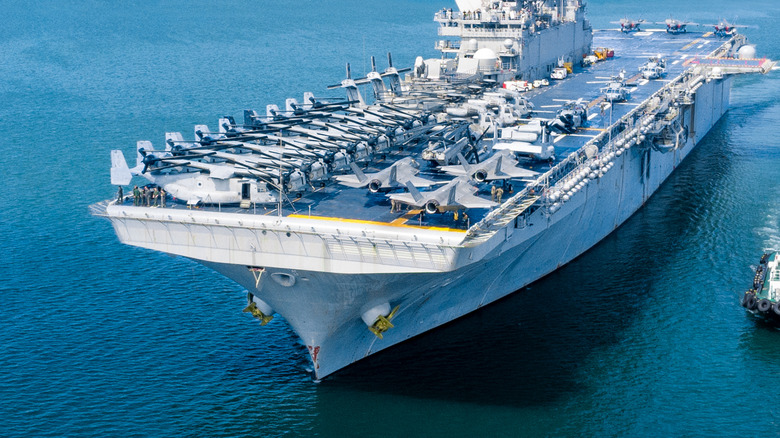Why US Aircraft Carriers Are Extremely Hard To Sink
Today's generation most likely associates aircraft carriers with the Tom Cruise blockbuster, "Top Gun." In fact, many pilots have gone on record, crediting the film as being the sole reason they joined the Navy in the first place. Carriers are the world's largest and most powerful warships – basically floating cities – capable of carrying a crew of 6,000 and 60 different aircraft of varying types and uses.
The United States fleet currently consists of 11 carriers, ten of which hail from the decades-old Nimitz class. Only one comes from the newest Ford class, which costs almost more to build than Canada spends on its entire annual defense budget.
A typical nuclear-powered Nimitz-class carrier has 25 decks layered together like a stack of pancakes, with hundreds of water-tight compartments scattered throughout. A Nimitz is 1,092 feet long (more than three football fields end to end) with a flight deck that covers more than four square acres. It sits 250 feet high and displaces some 100,000 tons of water when fully loaded.
There are several reasons why it's hard to sink a carrier, from the sheer size of the warship to how it's deliberately built to survive. According to Bryan Clark, a defense expert at the Center for Strategic and Budgetary Assessments (CSBA) and former U.S. Navy officer, an enemy could sink one if they had an overwhelming arsenal and enough time to deploy it. It's getting the time to do so that's really the issue.
The carrier is crafted to stay afloat
Aircraft carriers don't operate in isolation; they are part of a much larger strike group that typically includes a guided missile cruiser, a few guided missile destroyers, and at least one nuclear-powered attack submarine patrolling the waters underneath the fleet.
While the cruiser acts as the tip of the spear, it's also responsible for coordinating the integrated defense grid for the carrier. The cruisers are equipped with the networked AEGIS Weapon System, capable of autonomously defending against both air and surface threats and synchronizing and executing attacks against an enemy.
Additionally, both active and passive defenses include sensors, radar-guided missiles, and 20mm Gatling guns that shoot 50 rounds a second are used to protect the carrier. From early warning radar planes that can be sent out to detect distant threats (and jam radar and communications) to helicopters equipped with anti-sub, anti-surface, and counter-mine warfare detection systems, the Navy's aircraft carriers are the best-protected ships on the planet.
If an enemy somehow managed to breach every buffer zone, they would have to contend with the several layers of steel armor protecting all sides of the carrier's hull. Should a missile or torpedo strike the hull, voids inside the ship allow for warhead gas expansion. Plus, because an aircraft carrier is so large, it would take destroying most of its watertight compartments before it starts to sink. A scenario that, while not impossible, is unlikely to occur.
